MXA’S 2013 KAWASAKI KX450F MOTOCROSS TEST: THE SWEETEST POWERBAND POSSIBLE
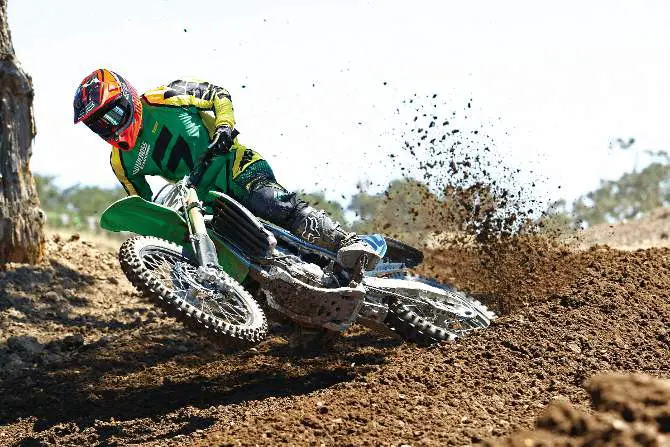
FIRST AND FOREMOST, IS THE 2013 KX450F BETTER THAN THE 2012 KX450F?
A: Yes, but only incrementally. Apart from the Kayaba air forks, the 2013 KX450F is a kissin’ cousin to the 2011 and 2012 KX450Fs.
Q: WHAT DID KAWASAKI CHANGE ON THE 2013 ENGINE?
A: The intake cam is new for 2013?not really. In truth, in 2012, Kawasaki installed an intake cam with 0.4mm more lift. Surprise, the 2013 KX450F cam has 0.4mm less lift. You don’t need Dr. Watson to tell you what happened here: Kawasaki put the 2011 cam in the 2013 KX450F.
The only other engine mod, apart from electronic trickery, is a new piston, which is really the same piston with a smoother crown for a better burn profile. The compression ratio is unchanged.
Q: IF THE ENGINE ISN’T NEW, THEN WHAT IS?
A: Kawasaki’s engineers made these changes for 2013.
(1) Swingarm. The front part of the KX450F swingarm has always been cast, but for 2013, the casting is 20 percent larger.
(2) Cosmetics . The front number plate is new, with the plate attaching to pins on the triple clamps instead of via pins on the number plate. The rear fender is now white, and the ignition/clutch covers are silver instead of dark gray. As an added touch, the timing plugs are anodized blue.
(3) Brakes. The front master cylinder is activated by a push-rod instead of by the lever pushing directly on the master cylinder’s piston. The rear rotor has a new cauliflower shape. The front brake pads have a higher coefficient of friction.
(4) Grips. Kawasaki has shaken up the staid grip community by switching to 10mm-wider grips. Even more significantly, they have stopped vulcanizing the throttle grip to the throttle tube, which means that KX450F owners can change grips without having to buy an aftermarket throttle tube.
(5) Chain guide/buffer. The chain buffer on top of the swingarm is now made from a higher-density urethane, while the brackets holding the rear chain guide in place are stronger.
(6) Throttle cable . We noticed that the return throttle cable does not have an inline slack adjuster.
Q: WHAT IS THE BIGGEST UPGRADE OF 2013?
A: All the buzz revolves around the Kayaba Pneumatic Spring Forks (PSF). Replacing the steel coil springs with air means the PSF forks offer less friction, improved bottoming resistance, easier tuning and a 1.7-pound weight savings. The Kayaba air forks won’t set the world on fire, but they are better than the Kayaba AOSS forks from last year.
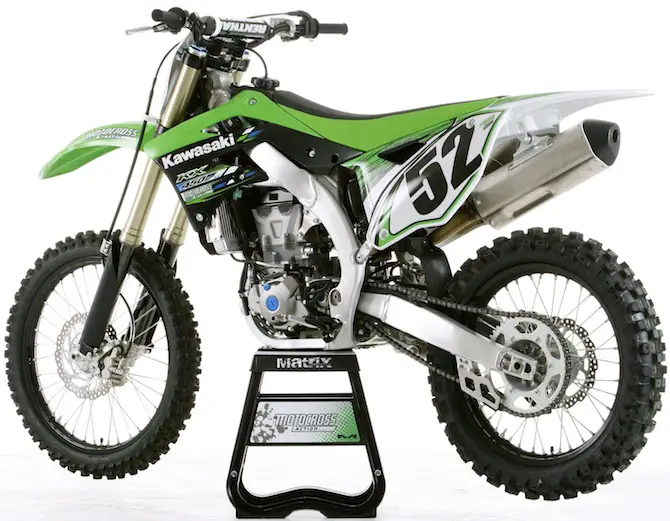
Less is more: Last year the KX450F was a fire-breathing dragon. Fast riders loved its instantaneous response. But, there was a more vocal group who felt that the power was too pro-oriented. The result? The 2013 KX450F engine is a kinder, gentler giant.
Q: WHAT ARE 10 THINGS EVERYONE SHOULD KNOW ABOUT AIR FORKS?
A: Unless you raced motocross from 1974 to 1979, you will have little or no experience with air forks. There are 10 things you need to know.
(1) Newness. Air forks are not new to motocross. As far back as 37 years ago, Yamaha was offering YZ125, YZ250 and YZ400 models with air forks, the so-called “speedo and tach” forks. The idea had merit, but was hampered by incredibly bad damping and the tendency of the air to expand with heat, which made the forks get stiffer as the race wore on.
(2) Nitrogen. Although virtually every local racer will use air in the PSF forks, the factory teams will run nitrogen. Nitrogen is not rEquired and its advantage in a fork are often overstated.
(3) Base setting. The base air-pressure setting is 35 psi, but that is only the pressure at the start of the moto. Depending on the length of the moto and the roughness of the track, the PSF forks can gain as much as 5 psi due to heat expansion.
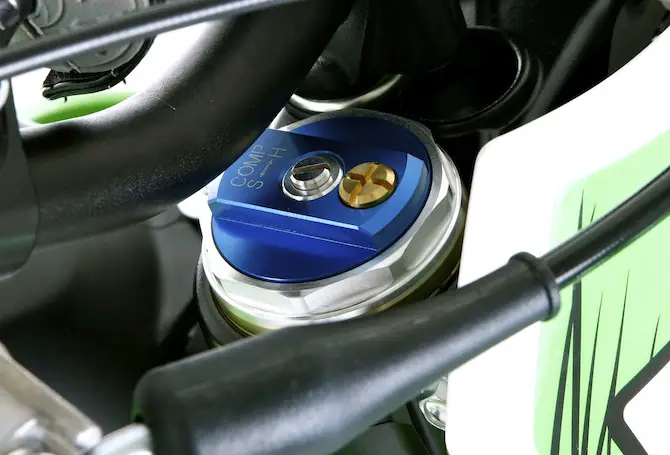
(4) Never-exceed number. The suggested pressure range on the KX450F is 32 psi to 41 psi. Never pressurize a PSF fork leg to more than 73 psi.
(5) Balloon. Air works as a spring when it is compressed (think of what happens when you squeeze a balloon). An air spring ramps up as it travels through its stroke. It can be easily adjusted to stop bottoming. Changing a steel coil spring is a labor-intensive job; adjusting air pressure only takes a few minutes.
(6) Extra cash. Budget an additional $49.95 into the price of the KX450F, because you must buy a KMC, Pro Circuit or DRC suspension pump to put air in or bleed it out. The bike comes with the special Schrader adapter valve required to access the PSF air valves (which are not Schrader).
(7) Schrader valves. Even if it would make fork adjustment easier, you should not race with the Schrader valve adapter attached to the fork caps. Roost could break it and allow the air to escape. On a side note, if you run your handlebars in the forward position, you will not be able to access the air valves without removing the bars.
(8) Oil height. Although the MXA wrecking crew has always harped on the importance of fork oil height on every fork design, air forks are infinitely more adjustable via fork oil height than coil spring forks. On a conventional, steel coil spring fork, changing the oil height does not make the coil spring stiffer. It only affects the small trapped air cavity at the top of the fork. On the PSF air fork, any oil height change will not just alter the way the fork feels in the last 4 inches of travel, but also ramp up the spring rate in the midstroke. The standard oil height is 245cc, and max oil height is 265cc.
(9) Advice. If you want a smoother feel in the first half of the fork’s stroke but more resistance to bottoming, don’t add air pressure; instead, add oil. If you want the fork to feel stiffer all the way through its stroke, add air and leave the oil height alone.
(10) Unsprung weight. Since the PSF forks weigh 1.7 pounds less than a coil spring fork, you might be tempted to think that they reduce unsprung weight by the same amount. Not true. Only one half of a coil spring’s weight is unsprung; thus an air spring only lowers unsprung weight by one-half of 1.7 pounds.
Q: HOW DOES IT RUN ON THE DYNO?
A: It makes 55.05 horsepower at peak (that is right between what the 2011 and 2012 KX450F made). Since it is a marriage of the 2011 and 2012 engines, it runs like the 2011 KX450F from off-idle all the way to 8000 rpm, and then from 9000 rpm on up it mimics the 2012 powerband all the way to sign-off. For comparison (omn the high and low sides), the 2013 KTM 450SXF makes 56.95 horsepower and the 2013 Honda CRF450 makes 51.5 horsepower.
For riders who complained about the abruptness of the 2012’s low-to-mid rush, this is exactly what the doctor ordered. If you liked last year’s engine use the aggressive map.

Brethren: How does the 2013 KX450F engine differ from the 2012 version? The 2013 uses the milder intake cam out of the 2011 model.
Q: HOW FAST IS THE 2013 KX450F?
A: There are parts of the powerband where it is giving up one to two horsepower to the 2012 engine, but this isn’t a chump-change engine; it can afford to give up power in the name of good manners when exiting turns or through tricky transitions. Many KX450F riders felt that the 2012 KX450F was too powerful off the bottom. The 2012’s high-lift cam focused more power lower in the rpm range. As a result, the 2012 KX450F felt barky, abrupt and powerful. Fast riders and horsepower freaks loved it, but it wasn’t the easiest power to meter out in small doses.
Thus, for 2013, Kawasaki’s engineers put the 2011 intake cam back in and called it a day. The MXA wrecking crew doesn’t have any major complaints about this strategy for two reasons:
First, the 2011 Kawasaki powerband was a thing of beauty. It was smooth down low and rolled on with authority. We can live with it.
Second, if we want more power and a barkier hit, all we have to do is put the 2012 KX450F intake cam back in or run the white map coupler. Simple Simon.
Q: IS THE 2013 KX450F TOO POWERFUL?
A: No, this is a fast motorcycle. Isn’t that what most motocross racers spend good money trying to achieve with pipes, cams, maps and head mods? With the Kawasaki KX450F, you don’t need to spend extra cash on the ponies?well, actually, you could save your hop-up money and spend it on the ponies at Santa Anita.
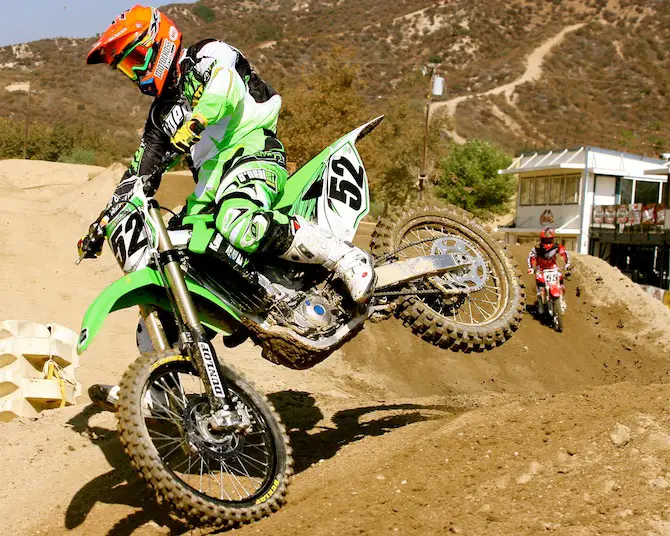
Q: WHICH MAP IS BEST? MELLOW, STOCK OR AGGRESSIVE?
A: The 2012?2013 KX450F comes with three plug-in maps. Kawasaki calls the maps “soft,” “hard” and “stock.” Ignore those names. Instead, call them “aggressive” (instead of soft), “mellow” (instead of hard) and “stock.”
Last year, almost every MXA test rider ran the mellow map (signified by the black plug-in connector). On the 2013 bike, the test riders were split between the aggressive (white) map and the stock (green) map.
Q: WHAT DO THE THREE MAPS RUN LIKE?
A: Pick your poison.
Stock map (green) . This was a good map and the choice of most Novice and Vet riders. It hit with a solid rush, but it wasn’t scary. Then, in the middle, it pulled strong and fast. It didn’t rev quickly, but it was easy to get back on the pipe if you dogged it out of the corner.
Mellow map (black) . Every test rider eschewed the mellow map. It was really hooked up and manageable through the midrange and was less likely to create wheelspin. It would be the perfect choice for ice racing or if they ever have an AMA National Linoleum Championship. Its worst trait was that it didn’t jump back up on the powerband very quickly.
Aggressive map (white) . In 2012, the aggressive map hit very hard and was amazingly powerful off the bottom. Not so this year. For 2013 the aggressive map isn’t overbearing down low, but it revs quicker, gets on top of a gear quicker and pulls through the powerband faster.
On the dyno, there were no perceptible horsepower differences between the stock and aggressive maps. The white and green plugs are all about the feel and the speed of the engine’s turnover. On the other hand, the mellow map gave up one horsepower everywhere in the powerband.
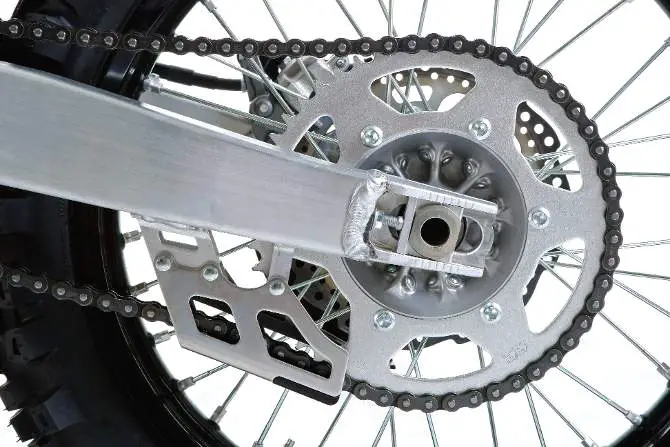
Monitor: The stock gearing is good for all-around use. Try plug-in EFI maps before gearing changes. Watch the chain guide closely.
Q: HOW DOES LAUNCH CONTROL WORK?
A: You should know that Ryan Villopoto does not use Launch Control on his factory KX450F. He wants every ounce of oomph that the engine has to offer. In function, Launch Control retards the ignition when the bike is in first or second gear (after the button has been pushed and while the light is flashing). How much does it retard the ignition? It has no effect on power below 7000 rpm. At 8000 rpm, the KX450F makes 1-1/2 horsepower less with Launch Control engaged and progressively makes less power as the rpm climbs until it peaks out at three horsepower less at 11,000 rpm. As a rule, we use this mantra: “Soft dirt, no Launch Control. Hard dirt, Launch Control.”
Q: HOW DOES THE 2013 KX450F HANDLE?
A: It’s no secret that we have struggled with the KX450F over the years. We never really liked its tendency to stand up in the center of corners and wallow under acceleration, but we forgave a lot of its peccadillos because the engine was so good. In 2012 Kawasaki finally made some headway in getting the KX450F to handle. They tamed the beast, and we think that the 2013 handles even better than the 2012. Given that the frame geometry, weight and setup are almost identical, we credit the suppler nature of the air forks, rigidity of the swingarm and mellower engine.
It is not a perfect machine. It has quirks that we may never come to terms with?at least not until it loses about 15 pounds of excess fat (it is 3 pounds lighter in 2013 than in 2012 at 239 pounds), an inch of seat height and a millimeter or two of fork offset.
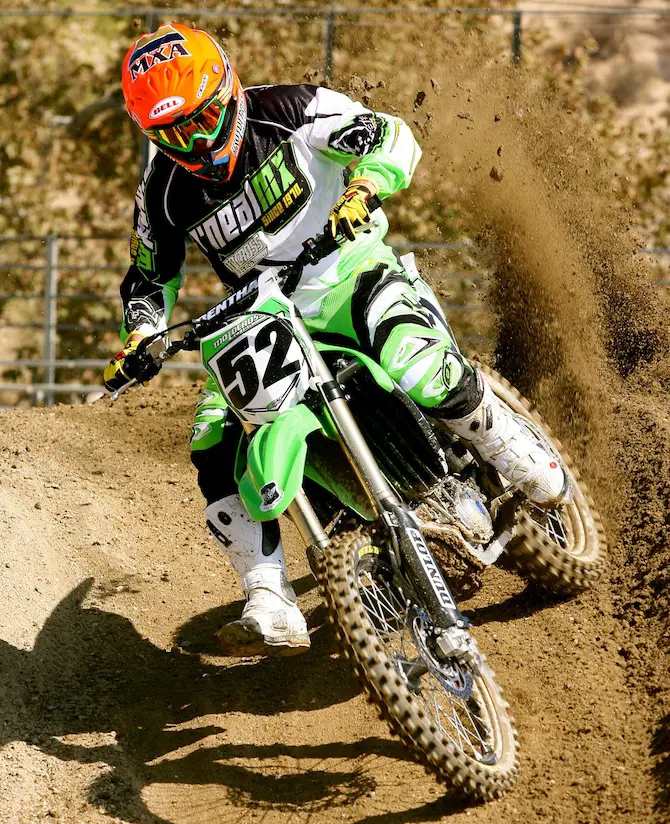
Q: WHAT DID WE HATE?
A: The hate list:
(1) Adjustable footpegs. We like the idea, but we don’t use them. Every MXA test rider put them in the “up” position and left them there.
(2) Brakes. New brake pads and a push-rod-style master cylinder actuator aren’t going to stop 239 pounds of romping-stomping mass in motion. As a credo, the company that makes the best powerband should also make the most powerful brakes.
(3) Weight. For the eighth year running, it’s too big, too tall and too heavy?but it isn’t the heaviest or even second heaviest 450.
(4) Sound. This is the loudest bike on the track. It made an ear-piercing 120.6 dB on the AMA two-meter-max test. It did pass the SAE 94 dB test (conducted at 4500 rpm).
(5) Fuel capacity. The KX450F only carries 1.64 gallons of gas.
Q: WHAT DID WE LIKE?
A: The like list:
(1) Tires. We love Bridgestone 403/404 tires.
(2) Adjustable maps. You gotta love a bike that comes with three different powerbands?that can be changed in 30 seconds.
(3) Launch Control. You can use it or ignore it, but it adds a new dimension when the situation arises.
Q: WHAT DO WE REALLY THINK?
A: The 2013 KX450F is a kinder and gentler version of the bike that won last year’s MXA 450 Shootout. The powerband is more usable, the suspension is improved and the handling is enhanced. For some riders the 2013 engine will be a step down from the awesomeness of 2012’s incredible power output. At day’s end, Kawasaki’s compromises made the 2013 KX450F a better bike than it was a year ago?but it could be so much better if it were smaller, lower and lighter.
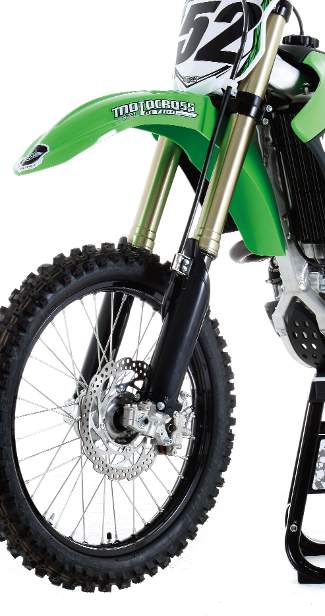
Air men: Living with Kayaba air forks is like owning a puppy. They both need constant attention, but are fun to play with.
MXA KAWASAKI KX450F SETUP SPECS
This is how we set up our Kawasaki KX450F for racing. We offer it as a guide to help you find your own sweet spot.
KAYABA PSF FORK SETTINGS
Don’t get too misty about the concept of air forks. The air is just a replacement for the standard-issue steel coil springs. Air offers the advantages of less weight, infinite adjustability and low cost. Its major downsides are that it needs to be constantly checked, a coil spring doesn’t leak and the pressure changes with ambient temperature. Most MXA test riders concentrated on getting the rebound damping spot-on, because when the rebound was too light, the forks felt bouncy. For hardcore racing, these are MXA‘s 2013 Kawasaki KX450F fork settings (stock settings are in parentheses).
Spring rate: 35 psi
Oil height: 245cc
Compression: 11 clicks out
Rebound:19 clicks out
Fork leg height: 5mm up
Notes: When the air pressure is wrong, you will recognize it right away. Too little air is worse than too much, but too much feels harsh and bounces. We started at 35 psi, but that is the cold air number. Once the bike was ridden, the air pressure went up as much as 4 psi. Since you can’t wait for the forks to cool down at the races, if the pressure climbs from 35 psi to 38 psi, but you want them stiffer, just add 1 psi to the 38 to make it 39 psi. Theoretically, going up 2 psi is the equivalent of going up one spring rate (from 0.47 to 0.48). Protect the fork seals with your life because when the start to leak it won’t be long until you go out to the garage one Sunday morning and find that you have a flat forks (We know from experience). As a side note:if you own a Honda with PSF forks, put Kawasaki seals in when the time comes for a rebuild?the KX450F seals are better.
KAYABA SHOCK SETTINGS
The 2013 shock has 33 rebound clicks instead of 22. The overall setup is decent, and we felt that the stock 5.5 kg/mm shock spring covered a wide range of test-rider weights. For hardcore racing, these are MXA‘s recommended 2013 KX450F shock settings (stock settings are in parentheses).
Spring rate: 5.5 kg/mm
Race sag: 100mm
Hi-compression: 2 turns out (1-3/4 turns out)
Lo-compression: 10 clicks out (8 out)
Rebound: 14 clicks out (19 clicks out)
Notes: Most MXA test riders prefer to run a longer 136mm shock linkage. It lowers the rear and lessens wallowing in the first half of the shock stroke.






Comments are closed.